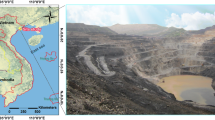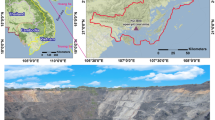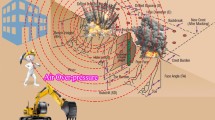Abstract
This study aims to take into account the feasibility of three ensemble machine learning algorithms for predicting blast-induced air over-pressure (AOp) in open-pit mine, including gradient boosting machine (GBM), random forest (RF), and Cubist. An empirical technique was also applied to predict AOp and compared with those of the ensemble models. To employ this study, 146 events of blast were investigated with 80% of the total database (approximately 118 blasting events) being used for developing the models, whereas the rest (20% ~ 28 blasts) were used to validate the models’ accuracy. RMSE, MAE, and R2 were used as performance indices for evaluating the reliability of the models. The findings revealed that the ensemble models yielded more precise accuracy than those of the empirical model. Of the ensemble models, the Cubist model provided better performance than those of RF and GBM models with RMSE, MAE, and R2 of 2.483, 0.976, and 0.956, respectively, whereas the RF and GBM models provided poorer accuracy with an RMSE of 2.579, 2.721; R2 of 0.953, 0.950, and MAE of 1.103, 1.498, respectively. In contrast, the empirical model was interpreted as the poorest model with an RMSE of 4.448, R2 of 0.872, and MAE of 3.719. In addition, other findings indicated that explosive charge capacity, spacing, stemming, monitoring distance, and air humidity were the most important inputs for the AOp predictive models using artificial intelligence.











Similar content being viewed by others
Change history
30 March 2021
A Correction to this paper has been published: https://doi.org/10.1007/s11600-021-00576-8
References
Alel MNA, Upom MRA, Abdullah RA, Abidin MHZ (2018) Optimizing blasting’s air overpressure prediction model using swarm intelligence. In: Journal of Physics: Conference Series, vol 1. IOP Publishing, p 012046
AminShokravi A, Eskandar H, Derakhsh AM, Rad HN, Ghanadi A (2018) The potential application of particle swarm optimization algorithm for forecasting the air-overpressure induced by mine blasting. Eng Comput 34(2):277–285. https://doi.org/10.1007/s00366-017-0539-5
Amiri M, Amnieh HB, Hasanipanah M, Khanli LM (2016) A new combination of artificial neural network and K-nearest neighbors models to predict blast-induced ground vibration and air-overpressure. Eng Comput 32(4):631–644
Armaghani DJ, Hajihassani M, Marto A, Faradonbeh RS, Mohamad ET (2015) Prediction of blast-induced air overpressure: a hybrid AI-based predictive model. Environ Monit Assess 187(11):666
Armaghani DJ, Hasanipanah M, Mohamad ET (2016) A combination of the ICA-ANN model to predict air-overpressure resulting from blasting. Eng Comput 32(1):155–171
Asteris PG, Nikoo M (2019) Artificial bee colony-based neural network for the prediction of the fundamental period of infilled frame structures. Neural Comput Appl. https://doi.org/10.1007/s00521-018-03965-1
Asteris P, Kolovos K, Douvika M, Roinos K (2016) Prediction of self-compacting concrete strength using artificial neural networks. Eur J Environ Civ Eng 20(sup1):s102–s122
Bach NV, Nam BX, An ND, Hung TK (2012) Determination of blast-induced ground vibration for non-electric delay blasting (in Vietnamse). J SciTechnol Hanoi Univ Min Geol 38(02):25–28
Bernat K, Drzewiecki W (2015) A study of selected textural features usefulness for impervious surface coverage estimation using Landsat images. In: Image and signal processing for remote sensing XXI, 2015. International society for optics and photonics, p 964327
Breiman L (2001) Random for Mach Learn 45(1):5–32
Bui XN, Nguyen H, Le HA, Bui HB, Do NH (2019a) Prediction of blast-induced air over-pressure in open-pit mine: assessment of different artificial intelligence techniques. Nat Resour Res. https://doi.org/10.1007/s11053-019-09461-0
Bui X-N, Nguyen H, Le H-A, Bui H-B, Do N-H (2019b) Prediction of blast-induced air over-pressure in open-pit mine: assessment of different artificial intelligence techniques. Nat Res Res. https://doi.org/10.1007/s11053-019-09461-0
Dou J, Yunus AP, Bui DT, Merghadi A, Sahana M, Zhu Z, Chen C-W, Khosravi K, Yang Y, Pham BT (2019) Assessment of advanced random forest and decision tree algorithms for modeling rainfall-induced landslide susceptibility in the Izu-Oshima Volcanic Island, Japan. Sci Total Environ 662:332–346
Drzewiecki W (2016) Comparison of selected machine learning algorithms for sub-pixel imperviousness change assessment. In: Geodetic Congress (Geomatics), Baltic, 2016. IEEE, pp 67–72
Friedman J (1999) Greedy function approximation: A stochastic boosting machine. Department of Statistics Stanford University
Friedman JH (2001) Greedy function approximation: a gradient boosting machine. Ann Stat 29:1189–1232
Friedman JH (2002) Stochastic gradient boosting. Comput Stat Data Anal 38(4):367–378
Gao W, Guirao JL, Basavanagoud B, Wu J (2018) Partial multi-dividing ontology learning algorithm. Inf Sci 467:35–58
Gao W, Alqahtani AS, Mubarakali A, Mavaluru D, Khalafi S (2019) Developing an innovative soft computing scheme for prediction of air overpressure resulting from mine blasting using GMDH optimized by GA. Eng Comput. https://doi.org/10.1007/s00366-019-00720-5
Hajihassani M, Armaghani DJ, Sohaei H, Mohamad ET, Marto A (2014) Prediction of airblast-overpressure induced by blasting using a hybrid artificial neural network and particle swarm optimization. Appl Acoust 80:57–67
Hasanipanah M, Armaghani DJ, Khamesi H, Amnieh HB, Ghoraba S (2016) Several non-linear models in estimating air-overpressure resulting from mine blasting. Eng Comput 32(3):441–455
Hustrulid W (1999) Blasting principles for open-pit blasting: theoretical foundations. Balkema, Rotterdam
Jhanwar J, Cakraborty A, Anireddy H, Jethwa J (1999) Application of air decks in production blasting to improve fragmentation and economics of an open pit mine. Geotech Geol Eng 17(1):37–57
Khandelwal M, Kankar P (2011) Prediction of blast-induced air overpressure using support vector machine. Arab J Geosci 4(3–4):427–433
Khandelwal M, Singh T (2005) Prediction of blast induced air overpressure in opencast mine. Noise Vib Worldw 36(2):7–16
Kuhn M, Weston S, Keefer C, Coulter N (2012) Cubist models for regression. R package Vignette R package version 00 18
Kuhn M, Weston S, Keefer C, Kuhn MM (2018) Package ‘Cubist’
Kuzu C, Fisne A, Ercelebi S (2009) Operational and geological parameters in the assessing blast induced airblast-overpressure in quarries. Appl Acoust 70(3):404–411
Loder B (1985) National Association of Australian State Road Authorities. In: Australian Workshop for Senior ASEAN Transport Officials, 1985, Canberra, 1987
Mahdiyar A, Marto A, Mirhosseinei SA (2018) Probabilistic air-overpressure simulation resulting from blasting operations. Environ Earth Sci 77(4):123
McKenzie C (1990) Quarry blast monitoring: technical and environmental perspectives. Quarry Manag 17:23–24
Mohamad ET, Armaghani DJ, Hasanipanah M, Murlidhar BR, Alel MNA (2016) Estimation of air-overpressure produced by blasting operation through a neuro-genetic technique. Environ Earth Sci 75(2):174
Montahaei M, Oskooi B (2014) Magnetotelluric inversion for azimuthally anisotropic resistivities employing artificial neural networks. Acta Geophys 62(1):12–43. https://doi.org/10.2478/s11600-013-0164-7
Naganna SR, Deka PC (2019) Artificial intelligence approaches for spatial modeling of streambed hydraulic conductivity. Acta Geophys. https://doi.org/10.1007/s11600-019-00283-5
Nguyen H, Bui X-N (2018a) Feasibility of artificial neural network in predicting blast-induced air overpressure in open-pit mine. J Min Ind 01:60–66
Nguyen H, Bui X-N (2018b) Predicting blast-induced air overpressure: a robust artificial intelligence system based on artificial neural networks and random forest. Nat Resour Res. https://doi.org/10.1007/s11053-018-9424-1
Nguyen H, Bui X-N, Tran Q-H (2017) Prediction of blast-induced air overpressure in Deo Nai open-pit coal mine using Random Forest algorithm. J Min Ind 06:47–53
Nguyen H, Bui X-N, Tran Q-H, Le T-Q, Do N-H, Hoa LTT (2018a) Evaluating and predicting blast-induced ground vibration in open-cast mine using ANN: a case study in Vietnam. SN Appl Sci 1(1):125. https://doi.org/10.1007/s42452-018-0136-2
Nguyen H, Bui XN, Bui HB, Mai NL (2018b) A comparative study of artificial neural networks in predicting blast-induced air-blast overpressure at Deo Nai open-pit coal mine, Vietnam. Neural Comput Appl. https://doi.org/10.1007/s00521-018-3717-5
Nguyen H, Bui X-N, Tran Q-H, Moayedi H (2019a) Predicting blast-induced peak particle velocity using BGAMs, ANN and SVM: a case study at the Nui Beo open-pit coal mine in Vietnam. Environ Earth Sci 78(15):479. https://doi.org/10.1007/s12665-019-8491-x
Nguyen H, Bui X-N, Tran Q-H, Mai N-L (2019b) A new soft computing model for estimating and controlling blast-produced ground vibration based on hierarchical K-means clustering and cubist algorithms. Appl Soft Comput 77:376–386. https://doi.org/10.1016/j.asoc.2019.01.042
Nguyen H, Moayedi H, Foong LK, Al Najjar HAH, Jusoh WAW, Rashid ASA, Jamali J (2019c) Optimizing ANN models with PSO for predicting short building seismic response. Eng Comput. https://doi.org/10.1007/s00366-019-00733-0
Nguyen H, Drebenstedt C, Bui X-N, Bui DT (2019d) Prediction of blast-induced ground vibration in an open-pit mine by a novel hybrid model based on clustering and artificial neural network. Nat Resour Res. https://doi.org/10.1007/s11053-019-09470-z
Nguyen H, Bui X-N, Bui H-B, Cuong DT (2019e) Developing an XGBoost model to predict blast-induced peak particle velocity in an open-pit mine: a case study. Acta Geophys 67(2):477–490. https://doi.org/10.1007/s11600-019-00268-4
Nguyen H, Bui X-N, Moayedi H (2019f) A comparison of advanced computational models and experimental techniques in predicting blast-induced ground vibration in open-pit coal mine. Acta Geophys. https://doi.org/10.1007/s11600-019-00304-3
Piasecki A, Jurasz J, Adamowski JF (2018) Forecasting surface water-level fluctuations of a small glacial lake in Poland using a wavelet-based artificial intelligence method. Acta Geophys 66(5):1093–1107. https://doi.org/10.1007/s11600-018-0183-5
Pierini JO, Lovallo M, Telesca L, Gómez EA (2013) Investigating prediction performance of an artificial neural network and a numerical model of the tidal signal at Puerto Belgrano, Bahia Blanca Estuary (Argentina). Acta Geophys 61(6):1522–1537. https://doi.org/10.2478/s11600-012-0093-x
Quinlan JR (1992) Learning with continuous classes. In: 5th Australian joint conference on artificial intelligence. Singapore, pp 343–348
Quinlan R (2004) Data mining tools See5 and C5. 0
Rahmani Y, Farnood Ahmadi F (2018) Application of InSAR in measuring Earth’s surface deformation caused by groundwater extraction and modeling its behavior using time series analysis by artificial neural networks. Acta Geophys 66(5):1171–1184. https://doi.org/10.1007/s11600-018-0182-6
Rulequest (2016a) Data Mining with Cubist. https://www.rulequest.com/cubist-win.html. Accessed 26 Feb 2019
Rulequest (2016b) Data Mining with Cubist. https://www.rulequestcom/cubist-info.html RuleQuest Research Pty Ltd.,St. Ives, NSW, Australia
Saltelli A, Annoni P, Azzini I, Campolongo F, Ratto M, Tarantola S (2010) Variance based sensitivity analysis of model output Design and estimator for the total sensitivity index. Comput Phys Commun 181(2):259–270
Shang Y, Nguyen H, Bui X-N, Tran Q-H, Moayedi H (2019) A novel artificial intelligence approach to predict blast-induced ground vibration in open-pit mines based on the firefly algorithm and artificial neural network. Nat Resour Res. https://doi.org/10.1007/s11053-019-09503-7
Siskind DE, Stachura VJ, Stagg MS, Kopp JW (1980) Structure response and damage produced by airblast from surface mining. Citeseer
Tarantola S, Gatelli D, Kucherenko S, Mauntz W (2007) Estimating the approximation error when fixing unessential factors in global sensitivity analysis. Reliab Eng Syst Saf 92(7):957–960
Vigneau E, Courcoux P, Symoneaux R, Guérin L, Villière A (2018) Random forests: a machine learning methodology to highlight the volatile organic compounds involved in olfactory perception. Food Qual Prefer 68:135–145
Vinacomin (2015) Report on geological exploration of Coc Sau open pit coal mine, Quang Ninh, Vietnam (in Vietnamse-unpublished). VINACOMIN, Vietnam
Walter E (1990) Surface blast design. Prentice Hall, New Jersey
Wiszniowski J (2016) Applying the general regression neural network to ground motion prediction equations of induced events in the Legnica-Głogów copper district in Poland. Acta Geophys 64(6):2430–2448. https://doi.org/10.1515/acgeo-2016-0104
Zhang X, Nguyen H, Bui X-N, Tran Q-H, Nguyen D-A, Bui DT, Moayedi H (2019) Novel soft computing model for predicting blast-induced ground vibration in open-pit mines based on particle swarm optimization and XGBoost. Nat Resour Res. https://doi.org/10.1007/s11053-019-09492-7
Zhou J, Li E, Yang S, Wang M, Shi X, Yao S, Mitri HS (2019a) Slope stability prediction for circular mode failure using gradient boosting machine approach based on an updated database of case histories. Saf Sci 118:505–518
Zhou J, Nekouie A, Arslan CA, Pham BT, Hasanipanah M (2019b) Novel approach for forecasting the blast-induced AOp using a hybrid fuzzy system and firefly algorithm. Eng Comput. https://doi.org/10.1007/s00366-019-00725-0
Acknowledgements
This research was supported by Hanoi University of Mining and Geology (HUMG), Hanoi, Vietnam; Duy Tan University, Da Nang, Vietnam; and the Center for Mining, Electro-Mechanical research of HUMG.
Author information
Authors and Affiliations
Corresponding author
Ethics declarations
Conflict of interest
Authors declare that they have no conflict of interest
Rights and permissions
About this article
Cite this article
Nguyen, H., Bui, XN., Tran, QH. et al. A comparative study of empirical and ensemble machine learning algorithms in predicting air over-pressure in open-pit coal mine. Acta Geophys. 68, 325–336 (2020). https://doi.org/10.1007/s11600-019-00396-x
Received:
Accepted:
Published:
Issue Date:
DOI: https://doi.org/10.1007/s11600-019-00396-x




